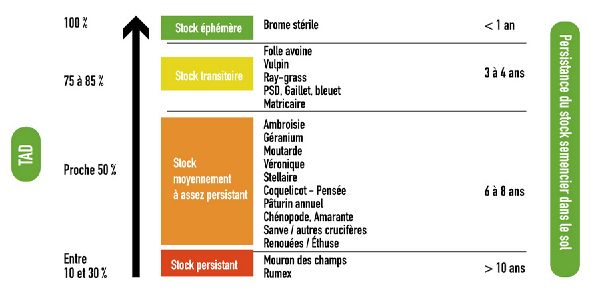 Chemical weeding, mechanical weeding, thermal weeding, electric weeding, tarps, cover crop destruction, weeds, ...
Chemical weeding, mechanical weeding, thermal weeding, electric weeding, tarps, cover crop destruction, weeds, ...

Weeding consists of combating the development of weeds ("bad weeds") whose presence harms cash crops. These plants, unintentionally introduced, can slow down the growth of crops and cause yield losses because they compete for resources (light, water, minerals…) or because they produce chemical substances with allelopathic effects. The presence of weeds can also be problematic at harvest time : presence of impurities, modification of harvest moisture…
Preventive control against weeds involves agronomic levers such as the choice of cultivated species, rotation length, sowing density…
Themes
Weed management using chemical plant protection products
Weed management using an electric current
Manual uprooting of weeds
Weed management using agricultural tools (tined weeder, rotary hoe...)
Weed management using agricultural tools (curly harrow, rotary hoe, etc.)
Weed management using heat
Weed control by cultural control
Agronomic levers for weed management (rotation, sowing, etc.)
Weed control by grazing animals
Weed management using grazing animals
Weed control using ground cover
Weed management using ground cover (tarpaulin, wool, etc.)
Weed management using robots (weeding robots, targeted spraying, etc.)
Weeding levers
Soil work
- Ploughing : buries the weeds present before sowing at a depth where they cannot germinate. Ploughing should be as shallow as possible (between 20 and 25cm deep). It is only effective if intermittent (between 2 and 3 years between each ploughing) because a second ploughing too early could bring seeds back to the surface and cause their germination.
- False seedbed : destroys the regrowth of annual weeds that emerge after harvest. The false seedbed also allows to make a maximum of weeds germinate with several passes to then destroy them (passes spaced 10 to 15 days apart). Different tools can be used, such as stubble harrows or disc harrows.
Rotation
- A meadow (or alfalfa) limits weed development thanks to a “cleaning” effect, as it prevents seed germination for several years.
- Alternation of sowing dates and diversity of species grown in the rotation: prioritize 2 spring crops then 2 autumn crops and not only winter or summer rotations.
Crop management
- Density and sowing spacing
- Shifting the sowing date (later date within the optimal window): effective for cereals in winter, on ryegrass (Lolium perenne) and blackgrass (a 10-day shift in October reduces ryegrass, blackgrass and brome grasses emergence by 50 to 75%)
- Cover crop and no-till under cover (permanent or annual)
- Mechanical weeding with a rotary hoe, a spring tine harrow or a rotary harrow
Maintaining plot cleanliness
“Preventive” treatments (to avoid plot contamination):
- Treat the field edges: prevents infestation from spreading to the entire plot
- Clean the combine harvester which may contain weed seeds
- Manual weeding on initial infestations, which is a more cost-effective method than soil work and herbicides on a fully contaminated plot
Other levers
- Herbicide banding: application of herbicide on the row and hoeing on the inter-row, this technique is used on row crops: corn, sunflower, soybean, rapeseed mainly.[1]
- Thermal weeding (market gardening): reduces seed germination potential [2]
- Green manure: soil cover crop intended either to be buried green in place by ploughing, or left in place as protective mulch for the following crop. It helps limit weed populations and can be used in arable farming, market gardening, vineyards and vineyards.[3]
Curative methods of weed destruction, before or after sowing, are numerous : manual weeding, using mechanical agricultural tools or robots, chemical products (herbicides), soil cover or thermal processes (solarization, flames, infrared) or electric. Grazing by animals also helps limit weed development.
Integrated pest management, which combines several weeding methods, aims to reduce the use of synthetic herbicides.
It is also possible to optimize weeding through knowledge of weeds which allows better targeting and more judicious use of control methods.
The first step is to revisit sites such as Infloweb, etc., to reacquire basics on the weeds to eliminate. Then one must study the properties of the weeds to adapt control.
Indicators for monitoring weed pressure
Annual decay rate (ADR)
The ADR corresponds to the percentage of seeds that will no longer be able to germinate after one year. The higher the ADR, the shorter the weed’s lifespan.[4]

Ploughing mainly targets weeds with a high ADR. To target weeds with low ADR, it is necessary to combine several levers (rotation, ploughing, temporary meadow, etc.)[5].
Emergence depth
Most seeds are present in the top 2 centimeters of soil and can germinate up to 5cm deep.
There are some exceptions:
- Blackgrass, ivy-leaved speedwell and bindweed can germinate up to 10cm deep
- Wild oat can germinate up to 30 cm deep
Emergence period
Annual weeds are characterized by emergence periods specific to each species. Some emerge over a relatively narrow period (e.g., blackgrass, mostly autumn and winter emergence) or conversely over a very wide or year-round period (e.g., annual Kentucky bluegrass).
Performing stubble cultivation or false seedbed must be done according to the targeted weed type and during periods when they are not able to germinate.[3]
Sources
- ↑ Chamber of Agriculture Gers, 2016: Herbicide bandinghttps://geco.ecophytopic.fr/documents/20182/21720/upload_00001637_pdf.pdf
- ↑ Caroline Bouvier d’Yvoire, 2018: Thermal weeding in market gardening https://www.produire-bio.fr/articles-pratiques/le-desherbage-thermique-en-maraichage/
- ↑ 3.0 3.1 Chamber of Agriculture Saône et Loire, 2022: How to control weeds with less herbicides in arable farming https://bourgognefranchecomte.chambres-agriculture.fr/fileadmin/user_upload/Bourgogne-Franche-Comte/061_Inst-Bourgogne-Franche-Comte/CA71/5_Techniques_Infos/56_Grandes_cultures/Maitrise_des_mauvaises_herbes_2022.pdf
- ↑ Chamber of Agriculture Normandy: Weeding https://normandie.chambres-agriculture.fr/conseils-et-services/produire-thematiques/cultures/conservation-des-sols/desherbage/
- ↑ Agridea, 2018: Cover crops in organic farminghttps://www.bonnepratiqueagricole.ch/fileadmin/user_upload/Biologie_des_adventices.pdf